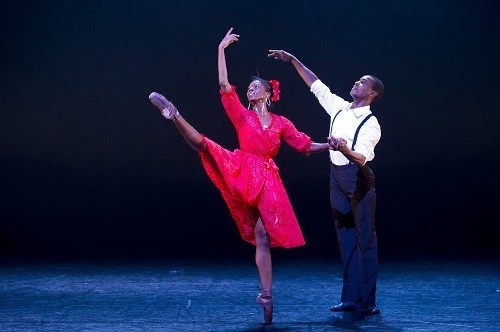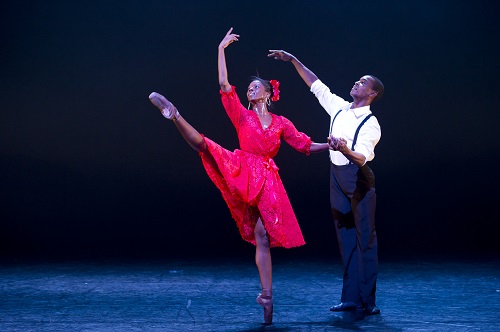 United Kingdom Pita, Marney, Hampson: Ballet Black, Barbican Centre, London, 19.3.2016. (J.O’D)
United Kingdom Pita, Marney, Hampson: Ballet Black, Barbican Centre, London, 19.3.2016. (J.O’D)

Cristaux
Dancers: Cira Robinson, Mthuthuzeli November
Choreography: Arthur Pita
Lighting Design: David Plater
Costume Design: Yann Seabra
Music: Steve Reich: Drumming Part III
To Begin, Begin
Dancers: Kanika Carr, Isabela Coracy, Joshua Harriette, Sayaka Ichikawa, Damien Johnson, Mthuthuzeli November, Cira Robinson, Jacob Wye
Choreography: Christopher Marney
Lighting Design: David Plater
Costume Design: Rebecca Hayes
Music: Dustin O’Halloran
Storyville
Dancers: Kanika Carr, Isabela Coracy, Joshua Harriette, Sayaka Ichikawa, Damien Johnson, Mthuthuzeli November, Cira Robinson, Jacob Wye
Choreography: Christopher Hampson
Lighting Design: David Plater
Costume & Prop Design:Gary Harris
Music: Songs and music of Kurt Weill
For the past three years, at least, Ballet Black has given its London performances in the Linbury Studio Theatre at the Royal Opera House. That rather cramped venue is now closed for refurbishment, so this year the company performed in the Barbican Theatre. It was gratifying, at the end of the evening, to look around the larger auditorium and see the audience applauding with enthusiasm from every part of it. The works by Arthur Pita, Christopher Marney and Christopher Hampson, may have had their errors in structure and execution, but there could be no doubt of the triple bill’s overall success.
Ballet Black premiered Pita’s Dream within a Midsummer Night’s Dream two years ago. In Cristaux, the London Contemporary Dance School-trained choreographer once again uses classical ballet to represent something cold, expressionless and hard. Cira Robinson bourrées on to the stage with her back to the audience in a tutu that is a sparkling Swarovski carapace of silver and grey. If her legs are those of a classical ballet dancer, Robinson’s head and arms make movements that are faceted and sharp. Her presence rouses the male dancer in this duet, Mthuthuzeli November, from his supine position on the floor.
Dazzling at first, Cristaux becomes less dazzling as it progresses. While Robinson and November perform to the music of Steve Reich with brittle exactitude, the climax to the piece does not come from the choreography. As in previous work by this choreographer (The Metamorphosis, Facada), it comes from a sudden and drastic alteration to the set.
Christopher Marney, who has choreographed for Ballet Black five times before, trained at the Central School of Ballet under the direction of Christopher Gable. He employs a softer, neo-classical vocabulary that perhaps shows the influence of Christopher Wheeldon. To Begin, Begin, with mellow music by Dustin O’Halloran, is the work of the evening in which all dancers are given the time and the space to look lovely (Kanika Carr’s arms; the lightness with which Jacob Wye lands from a leap or jump). A large square of blue material, not always easy to manipulate on this opening night, provides an ending that made the audience catch its breath in satisfaction and surprise.
Christopher Hampson, CEO/Artistic Director of Scottish Ballet, choreographed Storyville for Ballet Black in 2012. Set in New Orleans circa 1915, to the music and songs of Kurt Weill, it follows the young, innocent Nola (Cira Robinson) as she becomes the victim of dancehall hostess, Lulu White, and her business associate, Mack.
The first song is ‘Lost in the Stars’, to which the closely grouped dancers move the fingers of a raised hand in representation of stars. It is clear from the start that the narrative is not going to be a happy one. As the callous Lulu, Sayaka Ichikawa struts on pointe with arms akimbo. Almost singlehandedly, she takes this dark piece into its darkest territory.
The cast dance drunk to the ‘Canon Song’, tapping their glasses on the floor in unison. But the duets between Nola and her sailor boyfriend (Damien Johnson) seem generic. They slow things down. Cira Robinson, showing that a dancer can be drunk on pointe, too, manages to keep one’s belief in the piece alive as it moves to a reprise of the opening number at its inevitable conclusion.
John O’Dwyer
